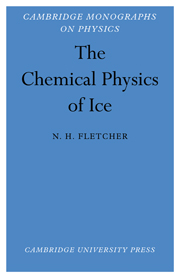Book contents
- Frontmatter
- Contents
- Preface
- Note on Units
- CHAPTER 1 The water molecule
- CHAPTER 2 Structure and energy of ordinary ice
- CHAPTER 3 Other forms of ice
- CHAPTER 4 Liquid water and freezing
- CHAPTER 5 Crystal growth
- CHAPTER 6 Thermal properties and lattice dynamics
- CHAPTER 7 Point defects
- CHAPTER 8 Mechanical properties
- CHAPTER 9 Electrical properties
- References
- Subject Index
CHAPTER 9 - Electrical properties
Published online by Cambridge University Press: 21 May 2010
- Frontmatter
- Contents
- Preface
- Note on Units
- CHAPTER 1 The water molecule
- CHAPTER 2 Structure and energy of ordinary ice
- CHAPTER 3 Other forms of ice
- CHAPTER 4 Liquid water and freezing
- CHAPTER 5 Crystal growth
- CHAPTER 6 Thermal properties and lattice dynamics
- CHAPTER 7 Point defects
- CHAPTER 8 Mechanical properties
- CHAPTER 9 Electrical properties
- References
- Subject Index
Summary
The electrical properties of ice have been studied, in recent years, more extensively than any other of its attributes. One reason is that a large variety of phenomena can be conveniently classified under this heading, while another is that, because many electrical properties are very sensitive to the purity of the crystal, the number of possible results is greatly multiplied and a detailed interpretation, though necessarily complicated, gives a considerable amount of insight into the molecular processes involved. Before we examine any topic in detail, therefore, let us make a brief survey of the field to be discussed to see what the phenomena are and, in general terms, how they can be interpreted.
Introductory survey
First consider the dielectric constant of pure ice as a function of frequency, as shown schematically in fig. 9.1. The static dielectric constant εs is very large, close to 100, and the mechanism responsible for it may reasonably be identified as the orientation of molecular dipoles preferentially in the direction of the field. The value of εs does not vary greatly with a small amount of impurity in the specimen, in agreement with this interpretation. As the frequency is increased through the kilohertz range, ε falls dramatically to a high–frequency value ε∞ = 3.2 which is maintained through the microwave region (Lamb & Turney, 1949).
- Type
- Chapter
- Information
- The Chemical Physics of Ice , pp. 198 - 246Publisher: Cambridge University PressPrint publication year: 1970
- 1
- Cited by



